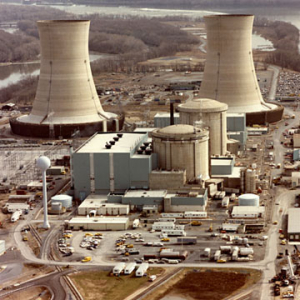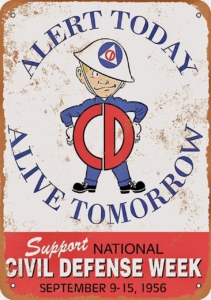Three Mile Island Lessons for COVID-19: FEMA and Me
 Forty-one years ago this summer I was a young investigator working in Harrisburg, Pennsylvania and Washington, DC for the President's Commission on the Accident at Three Mile Island, a big federal investigation chaired by Dartmouth Professor John Kemeny, who is best known as the father of the BASIC programming language. I learned a lot that summer and fall not only about nuclear accidents but about how governments and industries respond to crises. Some of those lessons apply to the current COVID-19 pandemic, which is also being poorly managed. This may surprise you (that 41-year-old lessons can still apply) but governments, especially, change at a glacial pace.
Forty-one years ago this summer I was a young investigator working in Harrisburg, Pennsylvania and Washington, DC for the President's Commission on the Accident at Three Mile Island, a big federal investigation chaired by Dartmouth Professor John Kemeny, who is best known as the father of the BASIC programming language. I learned a lot that summer and fall not only about nuclear accidents but about how governments and industries respond to crises. Some of those lessons apply to the current COVID-19 pandemic, which is also being poorly managed. This may surprise you (that 41-year-old lessons can still apply) but governments, especially, change at a glacial pace.
The two federal agencies with which I mainly dealt were the Federal Emergency Management Agency (FEMA) and the Nuclear Regulatory Commission (NRC). Both agencies had not long before gone through rebranding efforts so nearly all of the people I met had started their careers under the old brands - Civil Defense and the Atomic Energy Commission. These earlier identities are key to this story.
If you don't remember Civil Defense, it was the agency charged with planning what to do during World War III - a thermonuclear war that would have killed millions. Civil Defense built bomb shelters all over the country in the basements of public buildings, equipping them with survival supplies. Civil Defense ran weekly air raid tests where huge sirens could be heard all over town. Civil Defense taught little kids like me to hide under our school desks in hopes that would save us in case the nukes ever dropped.
But the nukes never dropped and eventually Civil Defense began to look less and less crucial to U.S. policy. Understand we were still in the Cold War. The Berlin Wall still stood and Ronald Reagan wasn't even running for President yet. But things were winding-down a bit, so it was decided that Civil Defense would be remade into FEMA and take on responsibility for other kinds of disasters like Hurricanes, tornadoes, and, well, nuclear accidents. Three Mile Island was their first one of those.
It didn't take long for me to realize that the Civil Defense folks I was meeting with (everyone was a man) both missed the old days of sparring with the Russkies and they were very uncertain how to handle these new kinds of emergencies like Three Mile Island, which we called TMI. The company that owned TMI, General Public Utilities, or GPU, was saying the plant was their baby, that the accident was all under control, and they'd be back up and running in no time at all. It was a complete lie of course, but FEMA didn't know that because FEMA didn't know much of anything.
Bob: What are you doing about the TMI accident?"
FEMA: We're monitoring the situation and supporting GPU, which seems to be doing a very good job."
In one sense it is hard to fault FEMA because they didn't know what they didn't know. But we can fault them on a kind of structural level for deferring to GPU. We see this a lot in regulatory bureaucracies. If someone else is going to grab responsibility for that huge and probably un-winnable crisis - that steaming pile of shit - heck, let them. Stand aside and watch the dummies fail. That's what FEMA did initially at TMI. It's a good way to cover your ass, but not at all a way to solve an actual crisis or to help your country. FEMA wasn't doing its job.
FEMA had to learn this same lesson again for Hurricane Katrina and then again for Hurricane Maria -two more huge disasters they were slow to enter.
Here is a point where we might ask what wasFEMA good at back in 1979? What did they see as their real reason for existing? I quickly learned that FEMA was really good at making maps and studying prevailing winds. They saw their true function as planning for a nuclear attack with the goal of minimizing loss of life in those first 30 days. Toward that end FEMA (as Civil Defense) had created and continually updated elaborate plans for moving large groups of people shortly after an attack. They'd leave the dead and move the living to places where they had calculated there would be less nuclear fallout driven by the wind.
Theirs' was a noble 30-year effort that resulted in ever more detailed and complex plans that diverted further and further from reality as the years passed. By 1979, FEMA's plan - just for the northeast states - was to move more than 50 million people over the 72 hours following a nuclear attack - an attack that would presumably have also destroyed most infrastructure.
Look at this in the context of the current COVID-19 crisis. In the current case we aren't being asked to move, we're being asked to not move, which is way simpler. Actual movement is limited to medical cases, personnel, and supplies. How are we doing with that? The streets are quiet, no nukes have destroyed them, and all we are trying to do is move a couple million people around and supply them with what they need. How is that going? It's not going well at all, frankly.
Now imagine it's happening during a nuclear war.
The old CD/FEMA evacuation plan was a lot like that GPS routing algorithm in your phone that has you make seven extra turns to save 0.3 miles on a 100-mile trip. IF they could move 50 million people from where there was more fallout to where there was a little less fallout (but still fallout) then a few thousand more people were calculated to survive ifthey actually made it to their destinations. And 30 days after that? That's where the Civil Defense plan stopped, so people who were now miles away from their homes and presumably still dying of radiation poisoning were, after 30 days, completely on their own. Yeah, right.
I'm telling you this because yesterday the CDC and FEMA announced they are working on a back-to-work plan for America. Is this starting to sound familiar?
I'm not saying the FEMA/CDC plan is bad. I simply don't know their plan. But if I had to bet I'd say the plan isn't very good. And the reason it isn't very good is because - just like the old CD evacuation plan - it is starting with a fundamentally bad idea, which in this case is how do we get the economy up and running by June 1 while killing the least people?"
They won't say that's the goal, but that is the goal because it is President Trump's goal.
The CDC and FEMA wouldn't be even going public with a plan at this point if they weren't being pushed into it by the White House.
So their goal is wrong. It probably should be how do we eventually get back to work with minimal loss of life?" They may even say that's the goal. But we all know the real goal is how do we get back to work by June 1 with minimal loss of life?"
The difference between those two goals is probably somewhere between 30,000 and 50,000 dead people - people who will have died so Donald Trump has a hope of being re-elected.
In my meetings with FEMA back in 1979, I asked questions that, I thought, got to the heart of the TMI crisis management problem. They didn't like my questions. They didn't like that I was asking questions at all. And that's when they would start tapping their West Point class rings on the conference table.
To the fine men of FEMA in 1979, I was a punk. But I was a punk working for the President of the United States. And that President, Jimmy Carter, was himself a graduate of the U.S. Naval Academy and had a post-graduate degree in nuclear engineering. Jimmy Carter was no punk, so the FEMA guys had to take me seriously.
Shit.
So they tapped their class rings on the conference table to let me know they were the adults and I was a punk. But the truth eventually became clear that they had little idea what actually to do and were mainly hoping GPU was telling the truth, that the nuclear accident would be over in a couple of weeks, and that life would get back to normal. Does this sound somewhat familiar?
$10+ billion and 41 years later, GPU is bankrupt and dead and TMI is still costing money to fix.
Applied to COVID-19 that means we won't be back to work by June 1.
At this point, I had planned to move on to my adventures with the Nuclear Regulatory Commission, which made FEMA look like Eagle Scouts. But this is too long already, so that will be my next column.


Digital Branding
Web DesignMarketing